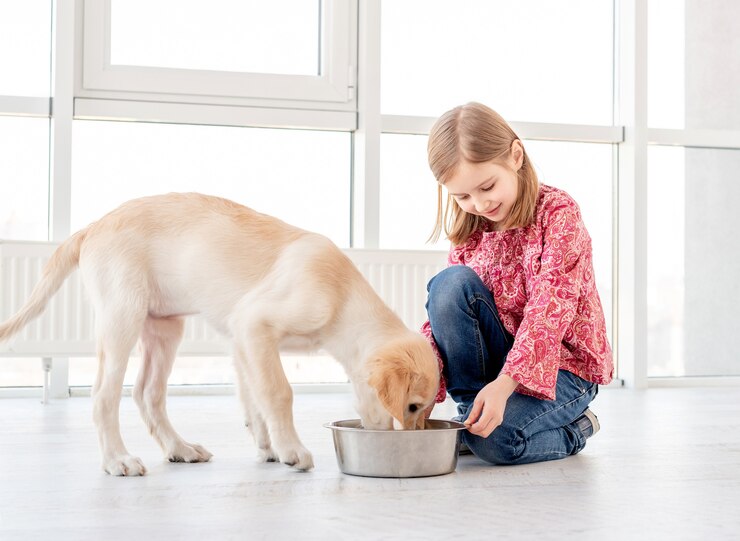Feed a Labrador Retriever puppy 3-4 times a day. Follow the guidelines on the puppy food packaging for portion sizes.
Raising a Labrador Retriever puppy requires proper nutrition. Consistent feeding schedules help ensure healthy growth and development. Puppies need more frequent meals compared to adult dogs. Choose high-quality puppy food rich in essential nutrients. Monitor your puppy’s weight and adjust portions as needed.
Overfeeding can lead to obesity, while underfeeding can stunt growth. Regular vet check-ups are crucial for personalized feeding advice. Socialize feeding times with training to build good habits. Proper hydration is equally important. Always provide fresh water. Feeding your Labrador Retriever puppy the right amount sets a solid foundation for a healthy, active life.
Feeding Basics
Labrador Retriever puppies need a balanced diet for healthy growth. They require high-quality proteins, fats, and carbohydrates. Essential vitamins and minerals are also important. Puppy food should be specially formulated for large breeds. Check the label for nutritional information. Avoid feeding adult dog food to puppies.
Feed Labrador Retriever puppies three to four times a day. This helps maintain steady energy levels. Puppies grow fast and need frequent meals. Spread meals evenly throughout the day. Avoid feeding too much at once. Overfeeding can cause digestive issues. Always provide fresh water with each meal.
Choosing The Right Food
Commercial food is easy to find and usually balanced. Many brands offer puppy formulas with essential nutrients. Homemade food allows control over ingredients. It can be tailored to your puppy’s needs. It is important to follow vet guidelines when making homemade food.
Reading labels helps in choosing the best food for your puppy. Check for key nutrients like protein, fat, and vitamins. Avoid foods with fillers and artificial additives. Look for high-quality ingredients listed first. Labels should also show the feeding guidelines.
Portion Sizes
Feeding a Labrador Retriever puppy requires balanced portion sizes to ensure healthy growth. Adjust meals based on age, weight, and activity level.
Age-based Portions
A Labrador Retriever puppy’s age affects its food portion size. Puppies aged 8-12 weeks need more food. They require about 4 meals a day. At 3-6 months old, reduce to 3 meals daily. By 6-12 months, 2 meals a day are sufficient. After one year, follow adult feeding guidelines.
Weight-based Portions
Weight also impacts the right portion size for a Labrador Retriever puppy. Puppies weighing 5-10 pounds need about 1.5 cups of food daily. Those between 10-20 pounds need about 2-2.5 cups. Puppies weighing 20-30 pounds require 2.5-3 cups. Adjust portions if the puppy gains or loses weight.
Feeding Schedule
A Labrador Retriever puppy needs to be fed three times a day. Feed your puppy in the morning, at noon, and in the evening. Make sure each meal is balanced and nutritious. Puppies have small stomachs and need frequent meals.
Start by feeding puppy food four times a day. At three months, reduce to three meals daily. After six months, switch to two meals per day. Always monitor your puppy’s weight and health during these transitions. Adjust portions if needed.
Special Dietary Needs
Labrador Retriever puppies may have allergies or sensitivities to certain foods. Common allergens include chicken, wheat, and soy. Observing your puppy’s reaction to new foods is important. Look for signs like itchiness, upset stomach, or excessive scratching.
Switching to hypoallergenic food can help. Consult your veterinarian for the best options. Always introduce new food gradually. This avoids sudden reactions and helps identify specific allergens.
Some puppies have medical conditions affecting their diet. Conditions like hip dysplasia or elbow dysplasia require special nutrition. Foods rich in glucosamine and chondroitin support joint health. Obesity is another concern. Maintain a balanced diet to prevent excessive weight gain.
For puppies with digestive issues, consider foods high in fiber and probiotics. These promote healthy digestion and nutrient absorption. Regular check-ups with your veterinarian ensure your puppy’s diet meets their specific needs.
Monitoring Growth
Feeding a Labrador Retriever puppy the right amount ensures healthy growth. Monitor their weight and adjust portions as needed. Consult your vet for personalized feeding guidelines.
Weight Tracking
Weigh your Labrador Retriever puppy every week. Keep a record of the weights. Use a chart to track the weight changes. Compare the puppy’s weight to breed standards. If the weight gain is too fast, adjust the food. If the weight gain is too slow, increase the food. A consistent weight gain is crucial for a healthy puppy.
Body Condition Scoring
Check your puppy’s body condition every week. Use a body condition score (BCS) chart. The BCS scale ranges from 1 to 9. A score of 4-5 is ideal for puppies. Feel the ribs with your fingers. The ribs should be easy to feel but not visible. Look at the puppy from above. The waist should be visible behind the ribs. Check the puppy’s belly. The belly should be tucked up, not sagging.
Treats And Snacks
Labrador Retriever puppies need balanced treats and snacks to support their growth. Feed small, nutrient-rich portions to avoid overfeeding.
Healthy Options
Choose fruits and vegetables as treats. Carrots and apples are great choices. Avoid giving grapes and raisins. They can be harmful. Lean meats like chicken are also good. Make sure they are cooked and unseasoned. Commercial dog treats can be used too. Look for those with natural ingredients. Avoid treats with artificial colors and preservatives. Puppy-specific treats are often best. These are designed for young dogs.
Portion Control
Too many treats can lead to weight gain. Limit treats to 10% of daily food intake. Measure treats before giving them. Use small pieces to avoid overfeeding. Training treats should be very small. This helps to keep calorie intake low. Monitor your puppy’s weight regularly. Adjust food and treats as needed. A healthy puppy is a happy puppy.
Common Feeding Mistakes
Overfeeding your Labrador Retriever puppy can lead to serious health issues. Excess weight can put a strain on their joints and bones. This can cause problems like hip dysplasia and arthritis. Puppies that eat too much can also suffer from digestive issues. It’s important to follow a feeding schedule and stick to recommended portions. Avoid giving too many treats or human food. These can add unnecessary calories. Always measure their food to ensure proper portion sizes.
Underfeeding can be just as harmful. Puppies need enough nutrients to grow and develop properly. Not eating enough can lead to malnutrition and poor growth. They may become lethargic and have a weakened immune system. Ensure they are getting a balanced diet with all the necessary vitamins and minerals. Check their weight regularly. Adjust their food intake if they are not gaining weight as expected. Consult your vet for personalized advice.
Another Post: Why Does My Dog Howl in His Sleep
FAQ
How Often Should I Feed My Labrador Puppy?
Feed your Labrador puppy three to four times a day. This ensures they get consistent nutrition and energy.
What Is The Ideal Portion Size?
Portion size depends on the puppy’s age, weight, and activity level. Generally, follow the guidelines on the puppy food packaging.
Can I Give My Labrador Puppy Treats?
Yes, but keep treats to less than 10% of their daily caloric intake. Use them for training and rewards.
Conclusion
Feeding a Labrador Retriever puppy correctly is essential for their growth and health. Monitor their weight and adjust portions as needed. Use high-quality puppy food and follow recommended guidelines. Always consult your vet for personalized advice. Proper nutrition ensures a happy and healthy Labrador Retriever puppy.

